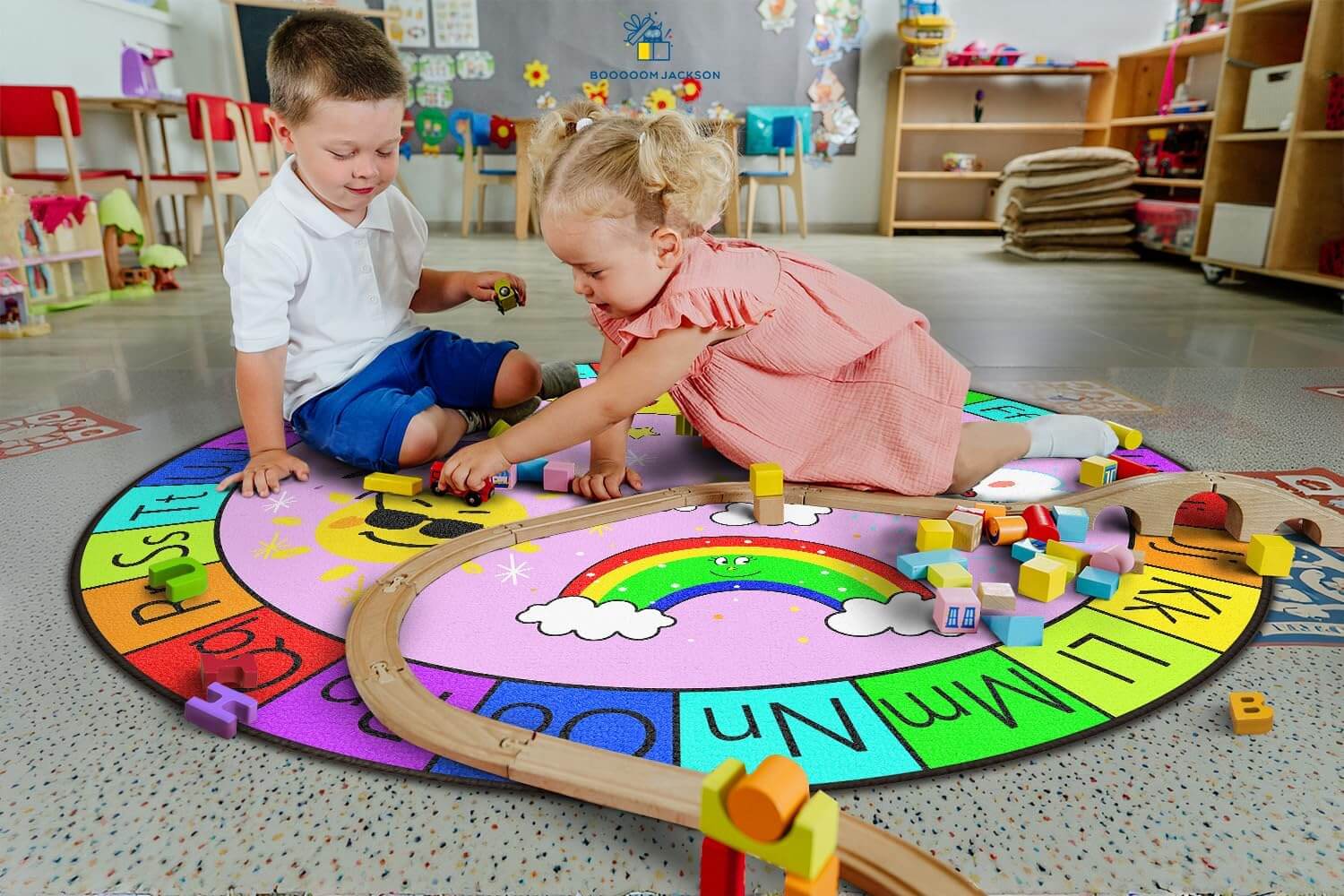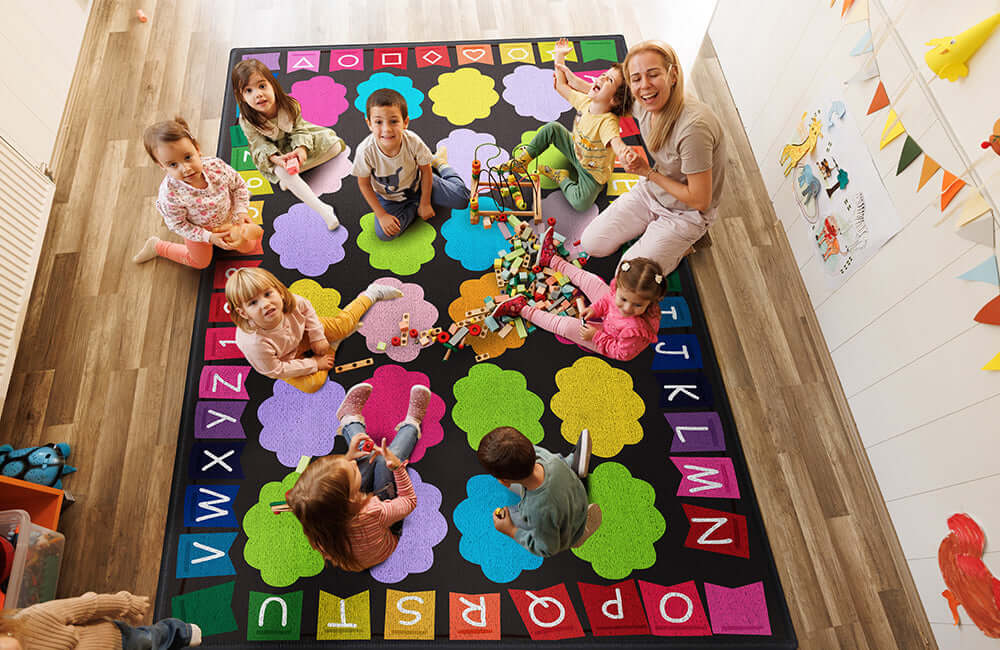Introduction {#introduction}
The surfaces children interact with daily profoundly impact their development in ways we're only beginning to fully understand. Among these surfaces, carpets hold a special significance—they're where babies take their first crawling journeys, toddlers spend hours at play, and older children gather for reading, crafting, and socializing. At Booom Jackson, we believe children's carpet design goes far beyond aesthetics; it's a powerful tool for shaping cognitive development, emotional well-being, and creative thinking.
Color Psychology in Children's Carpets {#color-psychology}
Colors don't just make carpets visually appealing—they profoundly influence mood, behavior, and cognitive processes. According to color psychology researchers, different hues affect children in specific ways:
Primary Colors and Cognitive Stimulation
Bright primary colors—red, blue, and yellow—stimulate young minds and capture attention. Our Primary Collection leverages these energetic hues strategically:
- Red areas increase energy and physical activity
- Blue zones promote calm, focus, and creative thinking
- Yellow sections enhance memory and optimism
Pastel Tones for Emotional Regulation
Softer, pastel versions of colors create more subdued environments that help children regulate emotions. As noted by child psychology experts, these gentler tones are especially beneficial in spaces designated for:
- Rest and quiet activities
- Overstimulation recovery
- Concentration-intensive learning
Color Combinations and Cognitive Benefits
Strategic color pairings in carpet designs can enhance specific developmental areas:
- Complementary colors (opposite on the color wheel) improve visual processing
- Analogous colors (adjacent on the color wheel) create harmony and reduce stress
- Monochromatic schemes with varying shades help children distinguish subtle differences
Our Color Theory Collection specifically incorporates these principles to support visual development and color discrimination skills.
Pattern Recognition and Cognitive Development {#pattern-recognition}
Patterns in carpet design do more than add visual interest—they actively train the brain in fundamental cognitive skills essential for academic success.
Mathematical Thinking Through Geometric Patterns
Geometric patterns introduce mathematical concepts organically through regular exposure:
- Repeating patterns develop sequencing skills essential for mathematics
- Symmetrical designs enhance spatial reasoning and logical thinking
- Fractals and tessellations introduce complex mathematical concepts naturally
According to educational neuroscience research, early pattern recognition is a powerful predictor of later mathematical ability. Our Geometric Wonders Collection is specifically designed to build these foundational skills through daily interaction.
Literacy Support Through Visual Discrimination
Pattern recognition directly correlates with reading readiness:
- Figure-ground discrimination helps children distinguish letters from backgrounds
- Visual tracking skills develop as eyes follow patterns across the carpet
- Symbol recognition is enhanced through exposure to varied visual elements
These skills transfer directly to literacy development as children learn to decode the symbolic patterns we call letters and words.
Sensory Integration Through Texture {#sensory-integration}
The tactile experience of carpet offers unique developmental benefits that smooth surfaces cannot provide.
Tactile Discrimination and Neural Mapping
Different carpet textures stimulate mechanoreceptors in the skin, supporting:
- Development of the somatosensory cortex (the brain's touch processing center)
- Refinement of fine touch discrimination
- Creation of detailed neural maps of the body
Our Multi-Texture Collection incorporates varied textures within single carpets, creating rich sensory landscapes for exploration.
Proprioceptive Feedback and Body Awareness
The slight resistance carpets provide offers important proprioceptive feedback:
- Crawling babies develop stronger muscles and better coordination
- Walking toddlers receive subtle feedback about balance and foot placement
- Seated children gain awareness of posture and body positioning
As noted by sensory integration specialists, this feedback is crucial for developing body awareness and motor planning skills.
Vestibular System Development
Carpet texture and thickness influence how children move across surfaces:
- Plush carpets require more deliberate movement, enhancing balance
- Varied textures encourage different movement patterns
- Textural boundaries create natural movement pathways
These experiences help calibrate the vestibular system—our internal sense of balance and spatial orientation.
Spatial Awareness and Navigation {#spatial-awareness}
Carpet designs with paths, zones, and landmarks help children develop critical spatial cognition skills.
Mental Mapping Skills
Carpets with distinctive regions function as spatial maps:
- Children create mental representations of the carpet's layout
- They learn to navigate between different areas
- They develop orientation skills by recognizing landmarks within the design
These skills directly translate to geographic understanding and navigation abilities. Our Cityscape Collection specifically supports spatial cognition through intricate urban layouts.
Perspective Taking Through Floor-Based Play
Playing on detailed carpet designs encourages children to:
- Imagine bird's-eye views versus ground-level perspectives
- Understand how objects relate to one another in space
- Develop early concepts of scale and proportion
According to cognitive development research, these perspective-taking experiences build foundations for later success in science, technology, engineering, and mathematics.
Boundary Recognition and Spatial Organization
Carpets naturally define areas within rooms:
- Children learn concepts of inside/outside and boundaries
- They practice organizing activities within defined spaces
- They develop respect for designated areas and their purposes
These experiences build organizational thinking and spatial planning abilities.
Thematic Design and Imaginative Play {#thematic-design}
Themed carpet designs serve as powerful scaffolds for narrative thinking and creative play.
Narrative Development Through Visual Prompts
Carpets featuring scenes, characters, or settings provide visual frameworks for storytelling:
- Children create narratives inspired by carpet elements
- They practice sequencing events (beginning, middle, end)
- They develop characters and scenarios based on visual cues
As noted by early literacy experts, these narrative experiences directly support reading comprehension skills by building story schema before formal reading instruction.
Symbolic Thinking and Abstract Reasoning
Themed carpets help children navigate between concrete and abstract thinking:
- A blue carpet area becomes an ocean in imaginative play
- Road patterns represent journeys and destinations
- Animal motifs inspire character development and role play
Our Fantasy World Collection specifically encourages this symbolic thinking through richly detailed imaginative landscapes.
Divergent Thinking and Creative Problem Solving
Well-designed thematic carpets promote multiple interpretations:
- The same carpet elements can be reimagined in different scenarios
- Children discover creative ways to incorporate carpet features into play
- They practice flexible thinking by adapting carpet themes to various games
According to creativity researchers, these early experiences with divergent thinking build neural pathways that support lifelong creative problem-solving.
Creating Psychological Safety Through Carpet Design {#psychological-safety}
The physical comfort of carpets contributes significantly to psychological well-being and emotional security.
Attachment and Security Through Defined Spaces
Carpets create consistent, recognizable spaces that foster security:
- Personal carpet spaces provide a sense of ownership and belonging
- Familiar carpet designs offer environmental consistency
- Soft textures provide comfort during emotional regulation
Our Comfort Zone Collection is specifically engineered to maximize psychological comfort through tactile features.
Acoustic Benefits and Stress Reduction
The sound-dampening qualities of carpets contribute to psychological comfort:
- Reduced noise levels lower stress hormones
- Improved acoustics support clearer communication
- Quieter environments enable better concentration and learning
These benefits are particularly important in group settings like classrooms and daycare centers.
Visual Clarity and Cognitive Load
Thoughtfully designed carpets can reduce visual chaos:
- Organized patterns create visual order
- Defined activity zones help children understand expectations
- Intentional color schemes prevent overstimulation
For children who struggle with sensory processing, these considerations are particularly crucial for successful engagement with their environment.
Age-Appropriate Design Considerations {#age-appropriate}
Optimal carpet design varies significantly based on developmental stage, with different features supporting specific age-related needs.
Infant Development (0-12 months)
For our youngest explorers, carpet design should prioritize:
- High-contrast patterns to support visual development
- Multiple textures for tactile exploration
- Hypoallergenic, non-toxic materials for safety during oral exploration
Our Baby's First Collection incorporates these features while maintaining appeal for the adults who share these spaces.
Toddler Exploration (1-3 years)
Active toddlers benefit from carpets that offer:
- Open-ended design elements that support evolving play skills
- Durable, easy-clean surfaces for messy developmental stages
- Physical activity prompts like pathways and jumping spots
According to toddler development specialists, these features support the explosive physical and cognitive growth of this stage.
Preschool Learning (3-5 years)
Preschoolers engage more purposefully with carpet features that offer:
- Literacy and numeracy elements like letters, numbers, and counting objects
- Social play zones that accommodate multiple children
- More complex patterns that challenge developing cognitive abilities
Our Preschool Prep Collection specifically targets these developmental needs.
School-Age Enrichment (6+ years)
Older children benefit from carpet designs that provide:
- Complex problem-solving elements like mazes or strategic games
- Cultural and scientific themes that expand knowledge
- Adaptable features that grow with changing interests
These designs respect children's increasing sophistication while continuing to support their developmental needs.
Inclusive Design for Diverse Developmental Needs {#inclusive-design}
Thoughtful carpet design considers the needs of all children, including those with developmental differences or disabilities.
Neurodiversity Considerations
For children with neurological differences such as autism spectrum conditions:
- Predictable patterns provide visual order and reduce anxiety
- Sensory-considerate textures accommodate tactile sensitivities
- Clear visual boundaries help with transitions and expectations
As noted by inclusive design specialists, these features benefit all children while being essential for some.
Motor Skill Variations
Children with diverse motor abilities benefit from:
- Multiple texture zones that provide different movement challenges
- Clearly defined pathways wide enough for mobility devices
- Secure surfaces that provide stability for those with balance challenges
Our Adaptive Play Collection incorporates these features while maintaining appealing designs for all users.
Sensory Integration Support
For children with sensory processing differences:
- Calming color palettes in some areas reduce overstimulation
- Defined sensory zones offer appropriate stimulation levels
- Mixture of simple and complex patterns provides choice in engagement level
These thoughtful considerations create truly inclusive environments where all children can thrive.
Conclusion {#conclusion}
The psychology of children's carpet design reveals how these seemingly simple floor coverings function as powerful developmental tools. Through strategic use of color, pattern, texture, and thematic elements, carpets can actively support cognitive development, emotional regulation, physical growth, and creative thinking.
At Booom Jackson, we approach carpet design as both an art and a science, drawing on research in developmental psychology, neuroscience, and education to create products that do more than beautify spaces—they actively contribute to optimal child development.
Whether you're a parent designing a nursery, an educator creating a learning environment, or a therapist setting up a treatment space, understanding these psychological principles can help you select carpets that not only look beautiful but also serve as valuable developmental partners in children's growth.
Explore our complete collection to discover carpets thoughtfully designed to support the developmental journey from infancy through childhood. Because when it comes to creating environments where children thrive, every element matters—right down to the very floor beneath their feet.
Have you noticed specific carpet features that seem to engage children in unique ways? Share your observations in the comments below!




Leave a comment
This site is protected by hCaptcha and the hCaptcha Privacy Policy and Terms of Service apply.